 Industrial Robots
Industrial Robots
Powering Industry with AI
Under the Trump Administration, America is bringing in trillions of dollars in investments for the manufacturing industry. And what is powering modern manufacturing...AI and Robotics.
When we think of robotics in manufacturing we think of industrial robots. Industrial robots are essential components in modern manufacturing plants, enhancing productivity, precision, safety, and efficiency. They perform repetitive, hazardous, or complex tasks with high accuracy, reducing labor costs and improving quality. They are improving manufacturing by automating tasks and enabling smart factories. The right robot depends on the application; whether it's high-speed assembly (SCARA), heavy payload handling (articulated), or safe human collaboration (cobots). AI software from companies like NVIDIA provides the platform for many of these industrial robots to operate.
 Let's take a deep dive into AI-driven robots in smart factories and
understand the power behind the new wave of manufacturing in America
courtesy of AI
Let's take a deep dive into AI-driven robots in smart factories and
understand the power behind the new wave of manufacturing in America
courtesy of AI
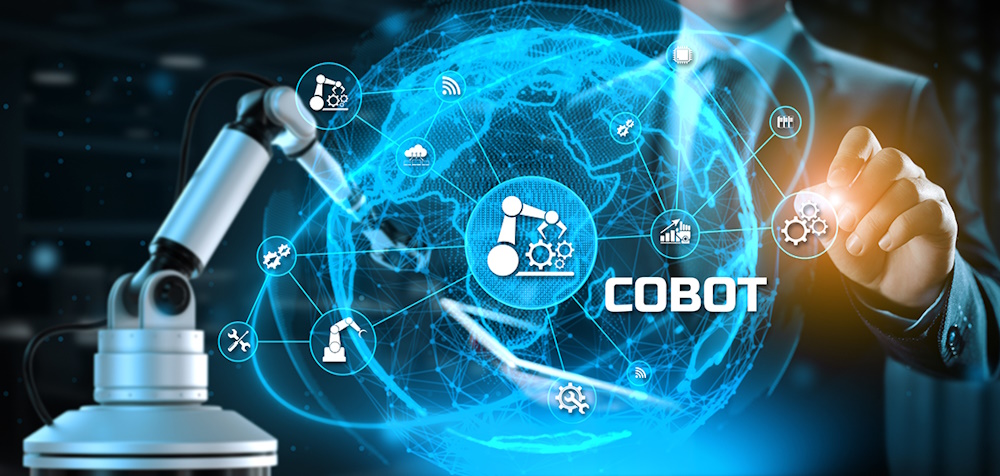
 Benefits of Industrial Robots
Benefits of Industrial Robots
- Higher Productivity: 24/7 operation with no fatigue
- Consistency: Reduced defects in production
- Cost Savings: Lower labor costs and waste reduction
- Safety: Handling hazardous tasks (chemicals, heavy loads)
- AI and IoT integration: Smart factories (Industry 4.0)
- Scalability: Easy reprogramming for new tasks
- Self-Learning Automation: Robots improve over time.
- Predictive Maintenance: Reduces unplanned downtime.
- Higher Precision: AI vision ensures defect-free production.
- Adaptive Manufacturing: Handles mixed-product batches.
- Energy Efficiency: AI optimizes power consumption.
Learn more...
- automate-uk.com/our-associations/bara/expert-advice/robots-explained/benefits-of-robots-in-manufacturing
- wipfli.com/insights/articles/mad-pros-and-cons-of-using-industrial-robots-in-manufacturing
- standardbots.com/blog/the-benefits-and-downsides-of-robotics-in-manufacturing
- dornerconveyors.com/blog/pros-and-cons-of-integrating-robotics-in-manufacturing
- azumuta.com/blog/how-is-ai-used-in-manufacturing-examples-use-cases-and-benefits
- blog.radwell.com/impact-of-artificial-intelligence-in-manufacturing-pros-and-cons
Types of Industrial Robots in Manufacturing
Articulated Robots 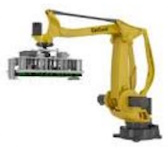
Articulated robots are a type of robotic system characterized by their jointed arms, which closely mimic the movement capabilities of a human arm. These robots typically feature rotary joints that provide multiple degrees of freedom, making them highly versatile and capable of complex tasks such as assembly, welding, painting, and material handling. These robots are widely used in industrial automation due to their precision, flexibility, and efficiency. They come in various configurations, including 4-axis, 6-axis, or more, depending on the requirements of the tasks they are designed for. Articulated robots are commonly employed in industries like automotive manufacturing, electronics, and healthcare. Applications include welding, assembly, material handling, and painting.
SCARA Robots 
SCARA robots, short for Selective Compliance Articulated Robot Arm, are a unique type of robotic system designed for high-speed, precise, and repetitive tasks. They are known for their rigid vertical axis and flexible horizontal movements, making them ideal for operations requiring lateral agility but minimal vertical play.
Key Features of SCARA Robots
- Selective Compliance: The arm provides flexibility in the horizontal plane while maintaining rigidity in the vertical direction, allowing for controlled precision in assembly and manufacturing tasks.
- Speed and Efficiency: SCARA robots are optimized for rapid and accurate movements, perfect for tasks such as pick-and-place, small parts assembly, and dispensing.
- Compact Design: With a relatively small footprint, they are well-suited for environments where space is at a premium.
- Features: High speed and precision in horizontal movements.
- Applications: Pick-and-place, assembly, packaging.
Common Applications
- Electronics Assembly: In industries like electronics, SCARA robots excel at assembling small components, such as circuit boards.
- Pick-and-Place: Their speed makes them ideal for handling repetitive pick-and-place tasks in manufacturing lines.
- Packaging and Sorting: Frequently used in industries like food and pharmaceuticals for sorting and packaging products with high precision.
Cartesian Robots 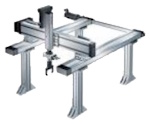
Cartesian robots, also known as gantry robots, operate based on Cartesian coordinate systems (X, Y, Z axes). They are characterized by their rigid structure and straightforward linear movements, which make them ideal for tasks requiring high precision and repeatability. Cartesian robots stand out for their simplicity and cost-effectiveness, especially when compared to other robot types with more complex motion capabilities.
Key Features of Cartesian Robots
- Linear Motion: Their design is based on straight-line movements along the three axes, which simplifies control and programming.
- High Payload Capacity: Gantry robots can handle heavy loads due to their robust framework, making them suitable for industrial applications.
- Scalability: Their size can be easily adjusted, ranging from small desktop systems to large-scale setups covering entire production lines.
- Operation: Linear movement along X, Y, Z axes.
- Applications: CNC machining, 3D printing, palletizing.
Common Applications
- Pick-and-Place Operations: Frequently used in assembly lines for positioning and transferring components.
- Material Handling: Ideal for palletizing, packaging, and loading tasks.
- 3D Printing and CNC: Often employed in additive manufacturing and machining processes for their precise and stable movements.
Delta Robots 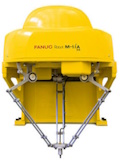
Delta robots, also known as parallel robots, are known for their unique design and incredible speed. They consist of three or more arms connected to a common base and operate using a parallel linkage system, which allows for exceptional precision and agility in tasks requiring rapid movement.
Key Features of Delta Robots
- High Speed: Designed for quick and repetitive tasks, they can achieve speeds that other robot types cannot match.
- Parallel Linkage: The arms work in unison, which contributes to both precision and stability in their movements.
- Compact Design: Delta robots are often mounted overhead, making them an excellent choice for space-constrained environments.
- Features: Lightweight, ultra-fast for delicate tasks.
- Applications: Food packaging, pharmaceutical sorting, electronics.
Common Applications
- Pick-and-Place Operations: Ideal for sorting, packaging, and assembling lightweight items in industries like food, pharmaceuticals, and electronics.
- Medical Industry: Used in high-precision applications such as surgery or delicate handling tasks.
- 3D Printing: Certain Delta robots are adapted for additive manufacturing due to their precise and swift motion.
- Delta robots are particularly valued for their speed and efficiency in applications requiring meticulous precision.
Collaborative Robots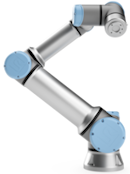
Unlike traditional industrial robots that operate in isolated areas, collaborative robots, often called cobots, are designed to work alongside humans in shared workspaces. Cobots are built with advanced safety features and intuitive programming to ensure seamless interaction with humans. Cobots are equipped with sensors, force limitations, and collision detection to prevent harm during interaction with humans. They are highly user-friendly, often requiring minimal programming knowledge. Many cobots are designed for "teach and repeat" operation, where they can learn tasks through direct guidance. Cobots can adapt to various tasks and are easily redeployed, making them suitable for dynamic and evolving production environments.
CCommon Applications
- Assembly: Assisting humans in intricate assembly tasks, particularly in industries like automotive and electronics.
- Pick-and-Place Operations: Useful in packaging, sorting, and material handling tasks.
- Quality Inspection: Performing precise inspections to ensure product consistency and accuracy.
- Healthcare: Cobots are used for patient assistance, lab automation, and even physical therapy applications.
- Cobots are transforming the way humans and robots collaborate, promoting safer and more efficient workplaces.
- Features: Safe to work alongside humans, easy programming.
- Applications: Small-part assembly, quality inspection.
Autonomous Mobile Robots (AMRs)
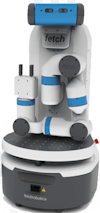
Autonomous Mobile Robots (AMRs) are advanced robots capable of navigating environments without direct human control. They use sophisticated sensors, cameras, and AI algorithms to make real-time decisions, allowing them to move safely and efficiently through dynamic spaces. AMRs are widely used in industries like logistics, manufacturing, healthcare, and retail to improve operations, reduce human workload, and increase efficiency.
Key Features
- AMRs are highly intelligent and navigate dynamically using sensors, cameras, and real-time mapping algorithms.
- They adapt to their environment, avoiding obstacles and rerouting as necessary without requiring predefined paths.
- These robots are equipped with software that allows them to make decisions, enabling flexible and autonomous movement.
Common Applications
- Warehousing: Picking, packing, and moving inventory efficiently.
- Healthcare: Delivering medications or supplies in hospitals.
- Retail: Stock transportation and replenishment.
Automated Guided Vehicles (AGVs)
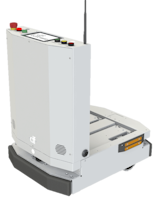
Automated Guided Vehicles (AGVs) are autonomous vehicles that navigate a facility without direct human intervention. They are equipped with various technologies such as lasers, cameras, magnetic strips, or GPS to follow predefined paths or adapt to dynamic environments.
Key Features
- AGVs follow fixed paths, often guided by magnetic strips, wires, or tracks embedded in the facility.
- They lack the dynamic adaptability of AMRs but are highly reliable for repetitive tasks within controlled environments.
- Simpler and often more affordable than AMRs.
Common Applications
- Manufacturing: Transporting parts or materials along a production line.
- Warehousing: Pallet handling and moving goods between fixed points.
 NVIDIA AI Software
NVIDIA AI Software
NVIDIA makes more than GPUs. AI Robot manufacturers collaborate with NVIDIA to leverage the NVIDIA Isaac and NVIDIA Omniverse platforms to accelerate development of AI-enabled robots. Using NVIDIA Isaac Sim, an application framework for robotic simulation and synthetic data generation, one company has reduced its robot programming time by 70% and cycle time by 20%, greatly lowering both time and costs. Digital twins provide robust support for collaborative robots by virtually modeling both the robots and their working environments. Using generative AI, tens of thousands of simulated data points can be produced, tested, and optimized in a virtual environment, training super-AI models that can drive major transformations across various industries.
Companies are also adopting NVIDIA Isaac Manipulator, a workflow of NVIDIA-accelerated libraries such as cuMotion, that enables manipulator robots to perceive, understand, and interact with their environments. In a depalletizing application, one company not only manually collected thousands of real-world data points for boxes of different sizes but also generated 90% of the required data using OpenUSD-based synthetic data generated by NVIDIA Isaac Sim. This virtual data, including images of palletized boxes with varying materials, prints, and palletizing conditions, helps bridge the data gap from the real world and train the box detection super-AI model. This super-AI model, combined with the full integration of the AI Cobot's software and hardware, brings revolutionary changes to the logistics industry.
 Key Applications
for AI Robotics in U.S. Manufacturing
Key Applications
for AI Robotics in U.S. Manufacturing
There are many companies in various industries that use AI and robotics in manufacturing in America. Here are a few examples:
Automotive (Tesla, Ford, GM)
Robots used: Fanuc, KUKA, ABB
Tasks:
Spot welding, painting, assembly
Electronics (Apple, Intel, Texas Instruments)
Robots used: SCARA,
Delta, Cobots
Tasks: PCB assembly, precision soldering
Food and Beverage (Nestle, PepsiCo)
Robots used: Delta, Hygienic
cobots
Tasks: Packaging, palletizing
Aerospace (Boeing, Lockheed Martin)
Robots used: Large 6-axis,
composites handling
Tasks: Drilling, painting, CFRP layup
Pharmaceuticals (Pfizer, Johnson and Johnson)
Robots used: Sterile
cobots, AMRs
Tasks: Lab automation, pill sorting
Learn more...
- digitaldefynd.com/IQ/ai-use-in-manufacturing-case-studies
- ifr.org/case-studies/service-robots-case-studies
- rstartec.com/insights/eight-ai-case-studies-demonstrate-the-potential-of-ai-in-manufacturing
- forbes.com/councils/forbestechcouncil/2025/03/13/ai-plus-robotics-intriguing-applications-in-surprising-industries
- vktr.com/ai-disruption/5-ai-case-studies-in-robotics
- automate.org/ai/industry-insights/case-studies-ai-advanced-manufacturing
- builtin.com/artificial-intelligence/ai-manufacturing-robots-automation
- controleng.com/four-ai-case-study-successes-in-industrial-manufacturing
- vaneck.com/us/en/blogs/thematic-investing/top-robotics-companies
- theaiinsider.tech/2025/01/15/50-robotics-companies-to-watch
- eweek.com/artificial-intelligence/robotics-companies/
AI is transforming industrial robotics, enabling self-learning automation, predictive maintenance, adaptive manufacturing, and more.
 How AI Enhances Industrial Robots
How AI Enhances Industrial Robots
AI-powered robots go beyond pre-programmed tasks, for they learn, adapt, and optimize in real time
Key AI technologies in robotics include:
- Computer Vision: Object recognition, defect detection.
- Machine Learning (ML): Predictive maintenance, process optimization.
- Deep Learning: Autonomous decision-making.
- Natural Language Processing (NLP): Voice-controlled robots.
- Reinforcement Learning: Self-improving robotic arms.
- Generative AI: Robot programming, managing inventory.
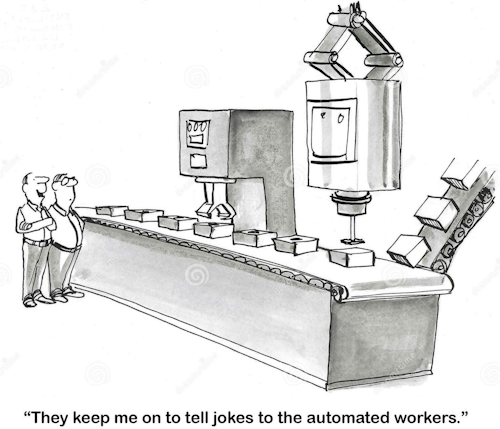
 Top AI-Powered Industrial Robots for Manufacturing
Top AI-Powered Industrial Robots for Manufacturing
Autonomous Mobile Robots (AMRs) with AI
Use Case: Smart logistics,
warehouse automation.
AI Features: Path optimization, obstacle
avoidance.
AI-Enabled Collaborative Robots (Cobots)
Use Case: Human-robot
teamwork with real-time adjustments.
AI Features: Force sensing,
adaptive gripping.
AI Vision-Guided Robots
Use Case: Quality inspection, bin picking.
AI Features: Defect detection, OCR reading.
AI-Powered Robotic Arms for Smart Factories
Use Case: Self-optimizing
welding, CNC tending.
AI Features: Adaptive welding, predictive
maintenance.
AI for Predictive Maintenance
Use Case: Reducing downtime with
real-time analytics.
AI Features: Vibration analysis, failure
prediction.
 AI Robotics Use Cases in Manufacturing
AI Robotics Use Cases in Manufacturing
Smart Quality Control
Robots equipped with vision systems and AI algorithms can detect defects
invisible to the human eye, ensuring consistent product quality. Companies
like Nissan use AI for precise assembly and quality control in electric
vehicle production, reducing defects and recalls.
AI Tech: Computer vision + deep learning.
Example: Detecting micro-defects in electronics.
Autonomous Material Handling
Autonomous mobile robots (AMRs) are being deployed for tasks like
material transport and inventory management. These robots reduce errors,
improve speed, and enhance operational flexibility. AI-driven robots now
perform complex tasks such as advanced planning, fault prediction, and
real-time decision-making.
AI Tech: Reinforcement learning for path
planning.
Example: AMRs navigating dynamic warehouses.
Self-Optimizing Welding and Assembly
AI Tech: ML-based parameter
adjustment.
Example: Adaptive arc welding in automotive plants.
AI-Powered Predictive Maintenance
AI Tech: Sensor data + anomaly
detection.
EExample: Preventing robotic arm failures before they happen.
Human-Robot Collaboration with AI
AI Tech: NLP + force feedback.
Example: Workers giving voice commands to cobots.
Learn more...
- techtarget.com/searcherp/feature/10-AI-use-cases-in-manufacturing
- gray.com/insights/four-use-cases-for-ais-growing-role-in-manufacturing/
- netsuite.com/portal/resource/articles/erp/ai-in-manufacturing
- markovate.com/blog/ai-use-cases-in-manufacturing
- vksapp.com/blog/ai-manufacturing-examples
 AI Robotics Manufacturing Jobs
AI Robotics Manufacturing Jobs
AI-powered smart factories are integrating AI, the Internet of Things (IoT), robotics, and big data analytics. These factories optimize production, reduce downtime, and improve efficiency. As a result, new job roles are emerging for the next generation of manufacturing plants. Be prepared for a rewarding career in a growth industry.
Here are some key AI-powered smart factory jobs:
AI and Machine Learning Engineers
Role: AI Engineers develop AI models for
predictive maintenance, quality control, and process optimization.
Skills: Python, TensorFlow/PyTorch, computer vision, reinforcement learning.
Industrial IoT (IIoT) Specialists
Role: Deploy and manage IoT sensors and networks for real-time data
collection.
Skills: IoT protocols (MQTT, OPC UA), edge computing,
cybersecurity.
Robotics and Automation Engineers
Role: Design and maintain collaborative robots (cobots) and autonomous
systems.
Skills: ROS (Robot Operating System), PLC programming,
mechatronics.
Data Scientists and Analysts
Role: Analyze manufacturing data to optimize production and reduce waste.
Skills: SQL, big data tools (Hadoop, Spark), statistical modeling.
Digital Twin Engineers
Digital twins simulate production processes, allowing manufacturers to optimize operations virtually before implementing changes on the factory floor. This minimizes downtime and enhances efficiency.
Role: Create virtual replicas of physical factories for simulation and
optimization.
Skills: CAD, simulation software (ANSYS, Siemens NX),
AI-driven modeling.
Smart Factory Cybersecurity Experts
Role: Protect AI and IoT systems from cyber threats.
Skills: Network
security, penetration testing, blockchain for secure transactions.
Predictive Maintenance Technicians
AI-powered predictive maintenance reduces equipment downtime by identifying potential failures before they occur. This approach is widely used in industries like automotive and electronics manufacturing.
Role: Use AI to predict equipment failures before they happen.
Skills: Condition monitoring, vibration analysis, AI-based diagnostics.
Manufacturing AI Consultants
Role: Advise companies on implementing AI-driven smart factory solutions.
Skills: Industry 4.0 knowledge, project management, business strategy.
AI Ethics and Compliance Officers
Role: Ensure AI systems in factories are fair, transparent, and
compliant.
Skills: AI ethics, regulatory standards (GDPR, ISO), risk
assessment.
Human-Robot Interaction (HRI) Specialists
Role: Improve collaboration between human workers and AI-driven robots.
Skills: UX design, cognitive ergonomics, safety protocols.
 Challenges of AI Robotics for Manufacturing
Challenges of AI Robotics for Manufacturing
- High implementation costs can be a barrier for smaller manufacturers.
- Workforce displacement due to automation may require reskilling programs.
- Data management issues, such as silos or cybersecurity risks, need to be addressed for seamless AI integration.
Learn more...
- consilien.com/news/ai-revolution-in-manufacturing-critical-challenges-opportunities
- themanufacturer.com/articles/the-challenges-preventing-ai-adoption-in-manufacturing
- strapi.vksapp.com/uploads/Challenges_of_AI_in_Manufacturing_2e83613920.jpg
- roboticstomorrow.com/news/2023/11/14/what-are-the-pros-and-cons-of-ai-robots
- macrometa.com/articles/the-advantages-and-disadvantages-of-automated-factories
- businessrecord.com/iowa-manufacturers-outline-advancements-challenges-from-integrating-ai-robotics-vision-systems-to-production
- techtarget.com/searcherp/tip/Challenges-of-using-AI-in-manufacturing
- essert.com/blog/robotics/challenges-benefits-robotic-manufacturing
 Future Trends in AI Robotics for Manufacturing
Future Trends in AI Robotics for Manufacturing
- AI aAI and Machine Learning: Smarter adaptive robots and a growing need for human workers.
- IoT Integration: Real-time monitoring and predictive maintenance.
- Human-Robot Collaboration: More advanced cobots and human operators.
- Sustainable Manufacturing: Energy-efficient robots.
- Generative AI for Robot Programming: ChatGPT-like interfaces for training robots.
- Swarm Robotics: AI-coordinated fleets of robots.
- Edge AI: Faster decision-making without cloud dependency.
- Digital Twins + AI: Simulating robot performance in virtual factories.
Learn more...
- bernardmarr.com/8-game-changing-manufacturing-trends-that-will-define
- ifr.org/ifr-press-releases/news/top-5-global-robotics-trends
- roboticstomorrow.com/story/2025/04/2025-trends-for-augmented-reality-in-manufacturing
- hanwha.com/newsroom/news/feature-stories/manufacturing-trends-for-2025-ai-automation-supply-chains-and-energy
- robotnik.eu/robotic-trends-in-2025-innovations-transforming-industries
- rockwellautomation.com/en-us/company/news/the-journal/8-key-industrial-automation-trends
- linkedin.com/pulse/top-ai-trends-manufacturing-2025-industry-40insights
- mdpi.com/2227-9717/13/3/832 trends and emerging applications
- robotnik.eu/the-future-is-here-artificial-intelligence-robots-transforming-industries
 Links
Links
roboticstomorrow.com/story/2024/08/ai-robots-transforming-industries-with-smart-robotic-solutions
ibm.com/think/topics/ai-in-manufacturing
therobotreport.com/top-10-robotics-developments
Blogs
imaginovation.net/blog/ai-in-manufacturing
l2l.com/blog/ai-in-manufacturing-where-weve-been-and-where-were-going
v7labs.com/blog/ai-in-robotics
itechcraft.com/blog/ai-in-manufacturing
tutorintelligence.com/blog/What-to-expect-from-AI-palletizing-robots